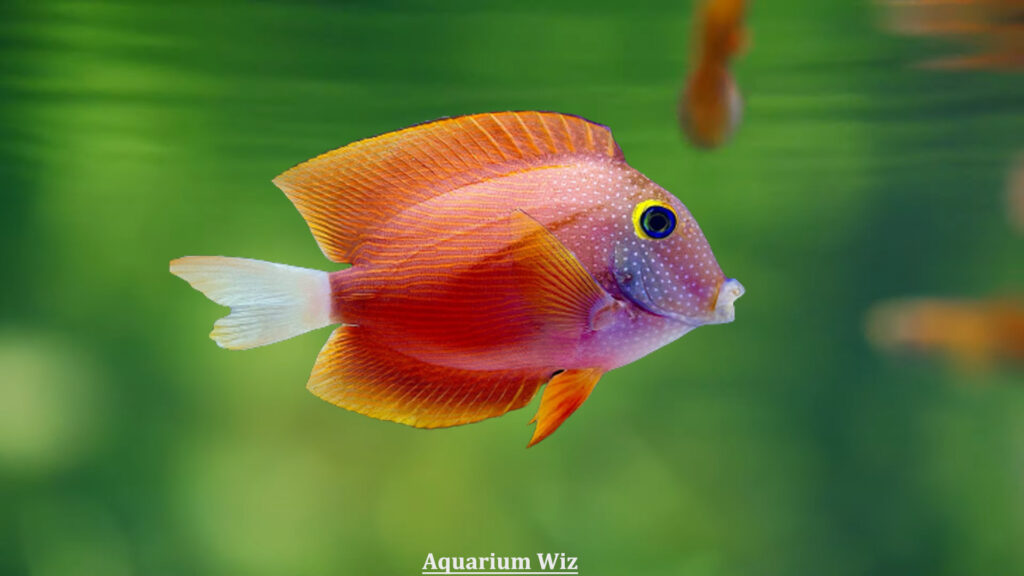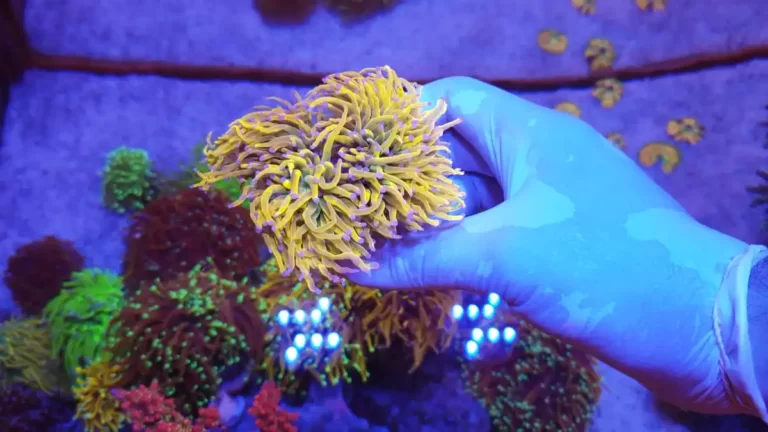White Tail Kole Tang | Care, Behavior, Diseases & Prevention
White Tail Kole Tang Overview
The White Tail Kole Tang, also known as the Yellow-eyed Tang or Bristletooth Tang, is a popular saltwater fish among marine aquarium enthusiasts. This species belongs to the Ctenochaetus genus and is native to the Pacific Ocean, specifically near Hawaii and the Philippines.
White Tail Kole Tangs have a brown body with about 35 fine, light, longitudinal lines that continue onto the rear of the soft dorsal and anal fins at the back of the body. Indian Ocean specimens bear spots, rather than the distinctive stripes. Their eye is encircled by a bright yellow ring, small blue spots on the face, and a striking white tail.
These fish are relatively small, growing up to a maximum length of 7 inches (18 cm) in the wild. In captivity, they typically grow up to 5 inches (13 cm) in length. They are also less aggressive than other Tang varieties, making them a peaceful addition to a community tank.
White Tail Kole Tangs are herbivorous and primarily feed on algae. They are known to be excellent algae eaters and can help maintain a healthy aquarium environment. However, it is important to provide them with a varied diet that includes seaweed, spirulina, and other vegetable matter.
Overall, the White Tail Kole Tang is a colorful and peaceful fish that can add a unique touch to any marine aquarium. With proper care and attention, they can live up to 10 years in captivity.

White Tail Kole Tang Care Guide
Tank Size
White Tail Kole Tangs require a minimum tank size of 75 gallons, but larger tanks are recommended. They are active swimmers and need plenty of space to move around. A larger tank will also provide more stable water conditions, which is important for their health.
Water Parameters
White Tail Kole Tangs prefer a temperature range of 72-78°F and a pH range of 8.1-8.4. They also require stable water conditions, so it’s important to monitor and maintain proper levels of ammonia, nitrite, and nitrate. A good quality protein skimmer is recommended to help maintain water quality.
Tank Setup
White Tail Kole Tangs need plenty of hiding places and live rock to graze on. They also require a sand substrate, as they like to sift through the sand looking for food. A good water flow is important to simulate their natural environment.
Size and Weight
White Tail Kole Tangs can grow up to 7 inches in length and weigh up to 3 pounds. They are relatively fast growers, so it’s important to provide them with plenty of space and food.
Food and Diet
White Tail Kole Tangs are herbivores and need a diet rich in algae. They will graze on live rock and sand, but it’s important to supplement their diet with Nori or other vegetable matter like Romaine lettuce, spinach leaves, or broccoli. They also will accept flake foods and sometimes small meaty offerings like Mysis shrimp.
What to Put in Their Tank
In addition to live rock and sand, White Tail Kole Tangs appreciate plenty of hiding places and swimming space. They do well with other peaceful fish and invertebrates, but should not be housed with aggressive or territorial species. It’s also important to provide a good water flow and maintain stable water conditions.
Behavior and Temperament
The White Tail Kole Tang is a peaceful and colorful saltwater fish popular among marine aquarium enthusiasts. They are known for their striking white tail and bristle-like teeth, which they use to graze on algae and other plant material. These fish are generally easy to care for and make great additions to a reef tank.
White Tail Kole Tangs are generally peaceful and get along well with other fish in the tank. However, they can become territorial and aggressive towards other tangs of the same species or similar shape and size. It is recommended to keep only one tang of the same species in a tank, and to introduce them to the tank at the same time to avoid territorial disputes.
In terms of swimming behavior, White Tail Kole Tangs are active swimmers and require plenty of open space to swim around. They are known to swim in a zig-zag pattern, which is a natural behavior in the wild to avoid predators. In an aquarium, they will often swim in the middle and bottom levels of the tank, but can also be seen swimming near the surface to gulp air.
White Tail Kole Tangs are also known for their ability to change color depending on their mood or environment. When stressed or frightened, they may darken their color to blend in with their surroundings. When happy and healthy, they will display their vibrant colors, making them a beautiful addition to any aquarium.
Appearance
The White Tail Kole Tang, also known as the Ctenochaetus Strigosus, is a beautiful fish that is native to the Southern Pacific region. These fish are known for their striking appearance, which includes a yellow ring around their eyes and two dark spots near their tail fin.
White Tail Kole Tangs have a brownish-blue body with a yellowish-orange tail. They also have bristle-like teeth that help them scrape algae off rocks and coral. These teeth are why they are commonly referred to as “Bristletooth Tangs.”
The average size of a White Tail Kole Tang is around 7 inches, although they can grow up to 9 inches in the wild. They are relatively hardy fish and can live for up to 10 years in a well-maintained aquarium.
When it comes to sexing White Tail Kole Tangs, males tend to be larger and have a more elongated body shape. Females are typically smaller and rounder. However, it can be difficult to tell the difference between males and females until they reach maturity.
Overall, the White Tail Kole Tang is a stunning fish that can add a pop of color to any aquarium. Their unique appearance and bristle-like teeth make them a fascinating species to observe.
Lifespan
The White Tail Kole Tang is a hardy and relatively long-lived saltwater fish that can live up to 10 years with proper care. However, the average lifespan of a Kole Tang is around 6 years in captivity.
The lifespan of a Kole Tang can be affected by several factors, including water quality, diet, and tank size. It is important to maintain a stable and clean environment with regular water changes to ensure the health and well-being of the fish.
In terms of diet, the Kole Tang is an herbivore and requires a diet rich in algae and vegetable matter. Providing a varied diet with high-quality foods will help ensure the fish receives all the necessary nutrients for a long and healthy life.
Lastly, the tank size can also play a role in the lifespan of a Kole Tang. The minimum tank size for a single Kole Tang is 75 gallons, and additional space should be provided for each additional fish. A larger tank will provide more swimming space and reduce stress on the fish, which can help extend its lifespan.
Overall, with proper care and attention, the White Tail Kole Tang can live a long and healthy life in captivity.
Common Possible Diseases & Prevention
White Tail Kole Tangs are generally hardy and healthy fish. However, they can still be susceptible to various diseases and infections. Here are some of the common possible diseases that White Tail Kole Tangs may experience and how to prevent them.
Head and Lateral Line Erosion Disease
Head and Lateral Line Erosion Disease (HLLE) is a common disease that affects many species of tangs, including White Tail Kole Tangs. It is caused by poor water quality, lack of proper nutrition, and stress. Symptoms include erosion of the head and lateral line, pitting, and discoloration.
Prevent HLLE by providing a balanced diet that includes plenty of algae, seaweed, and other greens. Avoid overfeeding and maintain excellent water quality by performing regular water changes, using high-quality filtration, and avoiding overstocking.
Ich
Ich, also known as white spot disease, is a parasitic infection that affects many species of fish, including White Tail Kole Tangs. Symptoms include the appearance of white spots on the fish’s body, fins, and gills, as well as scratching and flashing.
Prevent Ich by maintaining excellent water quality and avoiding overcrowding. Quarantine new fish before introducing them to the main tank, and treat any infected fish promptly with a suitable medication.
Velvet
Velvet is another parasitic infection that affects many species of fish, including White Tail Kole Tangs. It is caused by the dinoflagellate parasite Amyloodinium ocellatum. Symptoms include a yellow or gold dusting on the fish’s skin, rapid breathing, and lethargy.
Prevent velvet by maintaining excellent water quality, avoiding overcrowding, and quarantining new fish. Treat any infected fish promptly with a suitable medication.
Other Diseases
Other possible diseases that may affect White Tail Kole Tangs include bacterial infections, fungal infections, and parasitic infections such as flukes and worms. These can be prevented by maintaining excellent water quality, avoiding overcrowding, and quarantining new fish.
In summary, White Tail Kole Tangs are generally healthy and hardy fish, but they can still be affected by various diseases and infections. Prevent these diseases by maintaining excellent water quality, providing a balanced diet, avoiding overcrowding, and quarantining new fish. Treat any infected fish promptly with a suitable medication.
Related More: Lavender Tang Care : Everything You Need To Know
White Tail Tang vs Kole Tang
White Tail Tangs and Kole Tangs are both popular species in the aquarium trade. While they share some similarities, there are also some distinct differences between the two.
Appearance
White Tail Tangs (also known as Two Spot Bristletooth Tangs) have a distinct white tail, which is absent in Kole Tangs. Kole Tangs, on the other hand, have a more uniform coloration, with a brown body and yellow or orange highlights. Both species have bristle-like teeth that they use to scrape algae off rocks.
Size and Lifespan
Kole Tangs are generally larger than White Tail Tangs, with an average size of 7-9 inches compared to 5-6 inches for White Tail Tangs. In terms of lifespan, both species can live for up to 10 years in captivity with proper care.
Behavior
Both White Tail Tangs and Kole Tangs are generally peaceful fish that can be kept in community aquariums. However, Kole Tangs are known to be more aggressive towards other tangs, while White Tail Tangs are more docile. It’s important to provide ample swimming space and hiding spots for both species to prevent territorial disputes.
Diet
Both White Tail Tangs and Kole Tangs are herbivores and require a diet rich in algae and seaweed. They can also be fed commercial algae-based foods, such as spirulina flakes or pellets.
Tank Requirements
Both species require a large aquarium with plenty of swimming space and hiding spots. A minimum tank size of 75 gallons is recommended for Kole Tangs, while White Tail Tangs can be kept in slightly smaller tanks. It’s important to maintain stable water parameters, including temperature, pH, and salinity, to ensure the health of these fish.
In summary, while White Tail Tangs and Kole Tangs share some similarities, such as their herbivorous diet and bristle-like teeth, they also have distinct differences in appearance, size, behavior, and tank requirements. It’s important to research and understand the specific needs of each species before adding them to an aquarium.
Related Post: Bristletooth Tang Care: Everything You Need to Know
Frequently Asked Questions [FAQs]
What is the recommended tank size for a White Tail Kole Tang?
It is recommended to keep a White Tail Kole Tang in a tank of at least 75 gallons, as they need ample swimming space and territory to graze on algae.
What should I feed my White Tail Kole Tang?
Their diet primarily consists of marine algae and vegetation. Offer a variety of seaweed and algae sheets, and supplement with quality marine pellets or flakes designed for herbivorous fish.
Are White Tail Kole Tangs reef-safe?
Yes, they are generally considered reef-safe. They feed on algae and not coral or other invertebrates. However, they may nip at some types of soft corals, so monitor their behavior closely.
What are common diseases that affect White Tail Kole Tangs?
White Tail Kole Tangs can be susceptible to marine ich (white spot disease) and lateral line erosion. Proper quarantine and a stable tank environment can help prevent these issues.
How can I prevent diseases in my White Tail Kole Tang?
Maintaining good water quality, providing a balanced diet, and quarantining new additions to the tank can help prevent diseases. Regular observation and prompt action if you notice any signs of illness are crucial.





